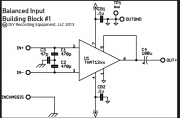According to Bill Whitlock, unbalanced cables result from one wire being grounded and the other wire carrying signal (normal for audio cables between the pre-amp and the amp). Balanced cables result from both wires (and everything connected to them) having the same impedance. This is hard to do.
Balanced cables originated in the telephone 600 Ohm lines that had to run long distances. They did this with an array of matching impedance equipment on both ends to reduce the signal loss.
My conclusion is that with short audio cable runs, we don't have much signal loss. We also want our pre-amp and amp power-line grounds connected together at the power outlet ground to reduce the risk of electric shock. Keeping the power-line grounds connected to a good electrical service ground can also reduce 60 Hz hum, if done correctly.
Microphones use balanced cables because their output is 5-50 millivolts and even a little signal loss is intolerable at those low levels. Many microphones "cheat" by not using a transformer to get a + and - differential output signal to drive a balanced XLR cable, the only downside is that with only one signal line, the output is cut by half.
Our pre-amps (and other input devices) typically output .3 to 2.0 volts (line level) and there is not much loss at that signal level. The exception is the turntable, the common moving magnet phono cartridge only outputs 3-6 millivolts (and a moving coil cartridge only puts out 1-1.5 millivolts). So, one would think that balanced cables would be ideally used for phonographs. Not so because the phono cartridge has no ground reference, it is floating. Floating sources connected to single-ended input (one signal wire and a common ground) with unbalanced cables act like they are connected by balanced cables. This is due to the impedance being the same in both wires because they are floating at the source. Therefore, the industry standard for phonographs is coaxial cables terminated with RCA plugs.
Because Phase Linear amplifiers are single ended input devices, the unbalanced, coaxial, shielded interconnect of six feet or less is the best way to connect the pre-amp to the amp. As Rod Elliot said, "In general, a home hi-fi needs balanced interconnects like a fish needs a bicycle, but someone, somewhere, decided that balanced connections 'sound better', but not because of noise reduction. Balanced connections are not used because they sound better or even different from any other. They are used where mains earth (ground) noise causes (or may cause) interference to the signal."

